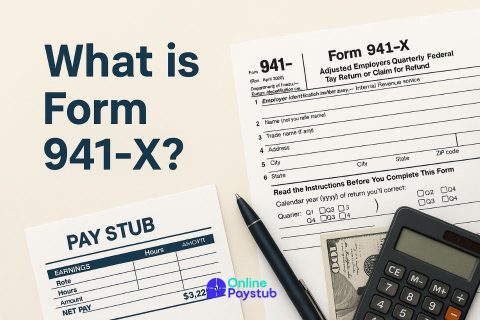IRS Form 940 is the official document used by employers to report their annual Federal Unemployment Tax Act (FUTA) tax. This tax is part of a dual system federal and state intended to fund unemployment compensation for workers who lose their jobs through no fault of their own. Unlike Social Security or Medicare taxes, the FUTA tax is not deducted from employees’ wages. Instead, it is entirely the employer’s responsibility.
At its core, the FUTA tax system ensures a stable funding mechanism for temporary financial assistance programs administered by states but supported by federal oversight. Employers contribute to this fund based on specific wage thresholds and employment activity throughout the year. The federal component, reported via Form 940, supplements state programs and acts as a financial backstop in times of economic stress or elevated unemployment.
Key Differences Between Form 940 and Other Employment Tax Forms
While Form 940 is focused exclusively on federal unemployment taxes, it is only one component of the broader employer tax reporting landscape. Employers are typically required to file multiple forms with the IRS, and understanding how Form 940 differs from other employment-related forms particularly Form 941 is essential for maintaining compliance and avoiding errors.
Form 940 is used to report and pay the Federal Unemployment Tax Act (FUTA) tax. It is filed annually and covers only the employer’s portion of unemployment taxes. Importantly, employees do not contribute to FUTA this is solely an employer liability.
By contrast, Form 941, the Employer’s Quarterly Federal Tax Return, is filed four times a year and includes withheld federal income tax, Social Security, and Medicare taxes from employees’ paychecks, as well as the employer’s matching share of Social Security and Medicare contributions. Unlike Form 940, Form 941 is directly tied to payroll deductions and reflects ongoing, periodic tax responsibilities throughout the year.
In addition to Forms 940 and 941, employers might also need to file:
- Schedule A or Schedule R if the business operates in multiple states or files as an aggregate employer under Form 940.
- Form 944, an annual version of Form 941 for smaller employers with lower tax liability.
- Form W-2, which reports employee earnings and taxes withheld.
FUTA Tax Scope and Wage Base
The FUTA tax applies to wages paid by employers to their employees, but its scope is more limited than other employment taxes. A clear understanding of the applicable wage base and exemptions is essential to correctly calculate the tax and avoid overpayment.
For each employee, only the first $7,000 of wages paid annually is subject to the FUTA tax. This is referred to as the FUTA wage base. Once an employee’s annual wages exceed this threshold, no further FUTA tax is due for that worker within the same tax year. This cap is applied individually to each employee, regardless of their role or compensation level.
The gross wage figure used to calculate FUTA tax includes more than just regular salary. Taxable FUTA wages generally encompass:
- Base wages, commissions, and bonuses
- Vacation pay and holiday pay
- Severance or dismissal payments
- Certain taxable fringe benefits
- Reportable tips
However, some payments are exempt from FUTA and should be deducted when calculating taxable wages. These include:
- Payments to independent contractors
- Payments to family members (e.g., children under 21, spouse, or parents) under specific business types
- Workers’ compensation for job-related injuries
- Non-cash compensation for agricultural or household workers
- Employee reimbursements under accountable plans
In addition to the federal guidelines, employers must also consider state-level unemployment insurance contributions. If state taxes are paid on time and in full, the employer is generally eligible for a 5.4% credit, reducing the FUTA tax rate from 6.0% to a net 0.6%. However, employers in designated credit reduction states are not eligible for the full credit and may owe a higher effective rate.
Which Businesses Must Submit Form 940
Not every business is required to file Form 940, but the IRS establishes clear thresholds that determine whether an employer is subject to FUTA tax reporting. Knowing whether your business meets these criteria is fundamental to avoiding noncompliance.
An employer must file Form 940 if either of the following conditions is met during the current or preceding calendar year:
- You paid wages totaling $1,500 or more in any calendar quarter.
- You employed at least one person (full-time, part-time, or temporary) for any portion of a day in 20 or more different weeks during the year.
These requirements apply regardless of business structure whether you’re a sole proprietor, corporation, nonprofit, or agricultural employer with a few specific exceptions. For example:
- Household employers must file Form 940 only if they paid $1,000 or more in cash wages in any calendar quarter.
- Farm employers are subject to different thresholds: either $20,000 or more in cash wages in a quarter or 10 or more farmworkers for part of a day in 20 weeks.
It’s also important to distinguish between independent contractors and employees. FUTA tax only applies to wages paid to employees. Misclassifying workers can trigger back taxes, interest, and penalties if an audit later determines those individuals should have been treated as employees.
Additionally, employers that ceased operations, had no employee compensation during the year, or changed ownership may still be required to file Form 940, often to report a final return or transfer responsibility. In such cases, they must indicate the special status directly on the form.
Employers operating in multiple states or in a credit reduction state must also attach Schedule A (Form 940), which outlines wage details on a state-by-state basis. Failing to submit this schedule when applicable may delay processing or result in incorrect credit calculation.
A Step-by-Step Guide to Accurately Completing Form 940
Filing Form 940 requires careful attention to detail and a structured approach. Each section of the form captures specific information about your business and its annual federal unemployment tax obligations. Below is a section-by-section breakdown to ensure accurate and compliant submission.
Business Identification
Begin by entering your Employer Identification Number (EIN), legal business name, trade name (if applicable), and mailing address. Inaccuracies here can delay processing or cause IRS mismatches.
Part 1: Multi-State and Credit Reduction State Status
- Indicate whether you paid wages in more than one state or in a credit reduction state (e.g., New York, California, U.S. Virgin Islands).
- If yes, you must also complete Schedule A (Form 940) to report FUTA wages by state.
Part 2: Calculating FUTA Tax Before Adjustments
- Line 3: Enter the total payments made to all employees during the calendar year.
- Line 4: Subtract any FUTA-exempt wages, such as those paid to family members or under workers’ compensation.
- Line 5: Subtract the portion of wages exceeding the $7,000 FUTA threshold per employee.
- Line 6: This gives your total taxable FUTA wages.
- Line 7: Multiply Line 6 by 0.006 (the effective tax rate, assuming full credit).
Part 3: Adjustments to FUTA Tax
- If any FUTA wages were not subject to state unemployment tax or if state taxes were paid late, use the IRS-provided worksheet to compute an adjustment.
- Line 10: Reflects the credit reduction adjustment, if applicable.
- Line 11: Enter the additional tax from Schedule A for wages paid in credit reduction states.
Part 4: Total FUTA Tax and Payments
- Line 12: Sum your total FUTA tax liability after adjustments.
- Line 13: Enter the total amount already deposited for FUTA during the year.
- Line 14: If this is more than the tax due, enter the overpayment. Otherwise, show the balance due.
Part 5: Quarterly Liability Breakdown
If your total FUTA tax on Line 12 exceeds $500, break it down by quarter in Part 5. This section is essential for verifying whether tax deposits were made on time.
Part 6 and 7: Authorization and Signature
- Sign and date the form.
- If a paid preparer completed the form on your behalf, they must include their information and sign as well.
- Optionally, you can authorize the preparer to speak with the IRS about the form.
State-Level Considerations and Credit Reductions
While the Federal Unemployment Tax Act (FUTA) is a federal program, its calculation and reporting are closely tied to the employer’s compliance with state-level unemployment tax systems. Proper coordination between federal and state tax responsibilities is essential to ensure accurate Form 940 reporting and to avoid unnecessary tax liability.
The Role of State Unemployment Insurance (SUI)
Each state administers its own unemployment insurance program, funded through employer payroll taxes. Employers are required to pay state unemployment tax (SUTA or SUI) on employee wages, and in most cases, doing so in a timely manner enables the employer to claim a FUTA tax credit.
The full FUTA tax rate is 6.0% on the first $7,000 paid to each employee annually. However, employers who pay state unemployment taxes on time and in full are eligible for a standard credit of 5.4%, effectively reducing their FUTA rate to 0.6%.
What Are Credit Reduction States?
Credit reduction state is one that has borrowed funds from the federal government to pay unemployment benefits and has not repaid them in time. Employers in these states are not eligible for the full FUTA credit and are required to pay an additional percentage on wages paid in that state.
For example, if the standard 5.4% credit is reduced by 0.6%, the effective FUTA tax rate for employers in that state becomes 1.2%. These reductions apply only to wages paid in those specific states.
The IRS publishes a list of credit reduction states annually, which must be checked before completing Form 940. For the 2024 tax year, known credit reduction states include California, New York, and the U.S. Virgin Islands.
Schedule A: Required for Multi-State Employers
If you paid wages in two or more states, or if any of your wages were paid in a credit reduction state, you must file Schedule A (Form 940) along with your main return. This schedule breaks down the FUTA wages by state, allowing the IRS to apply appropriate credit calculations.
Failure to file Schedule A when required can result in incorrect tax assessments, delays in processing, or even penalties. Proper recordkeeping and wage tracking by state are therefore necessary throughout the year—not just at filing time.
Multi-State Compliance and Software Integration
For employers operating across jurisdictions, coordinating state and federal requirements is complex. Payroll software or third-party providers can help streamline this process by automatically flagging credit reduction states, applying the correct rates, and generating the required forms.
Understanding your state-specific obligations and how they affect your FUTA calculation is not optional it’s integral to accurate Form 940 reporting and long-term tax efficiency.




No comments to show.